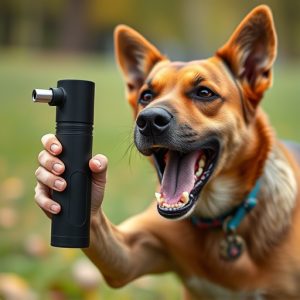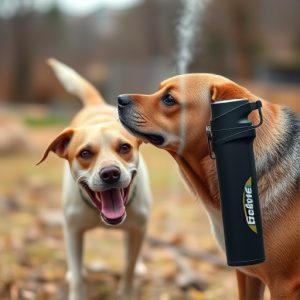Capsaicin in Dog Spray: Effective Deterrent or Safe Solution?
Dog spray, a popular deterrent for aggressive behavior, primarily contains capsaicin from chili pepp…….
Dog spray, a popular deterrent for aggressive behavior, primarily contains capsaicin from chili peppers with concentrations typically between 0.5% and 2%. Lower concentrations offer less protection, while higher levels provide more security but increase the risk of adverse effects on dogs and humans. Understanding potential risks and following safety guidelines is crucial when using dog spray. Efficacy testing under various real-world conditions simulates scenarios to ensure its reliability as a deterrent for canine aggression. Comparisons between brands based on capsaicin content are essential for safe, effective management of aggressive behavior.
Dog sprays have emerged as a popular choice for deterring unwanted dog behavior, but not all options are created equal. This article delves into the science behind dog spray, focusing on capsaicin—the active ingredient known for its effective deterrent properties. We present a comprehensive market analysis comparing top dog sprays with capsaicin content, while also exploring safety considerations and evaluating their performance in real-world scenarios. Understanding capsaicin’s role is key to making an informed choice for your canine companion’s well-being and behavior management.
- Understanding Dog Spray: Active Ingredients and Their Effects
- Capsaicin: The Science Behind the Spray's Deterrent Properties
- Market Analysis: A Comparison of Top Dog Sprays with Capsaicin Content
- Safety Considerations: Mitigating Risks for Both Dogs and Humans
- Efficacy Testing: Evaluating Dog Spray Performance in Real-World Scenarios
Understanding Dog Spray: Active Ingredients and Their Effects
Dog spray, also known as pepper spray for dogs, is a popular deterrent designed to protect against aggressive canine behavior. The primary active ingredient in most dog sprays is capsaicin, derived from chili peppers. This compound stimulates nerve endings, causing irritation and temporary blindness, which can deter a dog from advancing.
When it comes to dog spray capsicum content comparison, the concentration varies across brands. Typically, dog spray contains between 1% and 2% capsaicin. Higher concentrations offer more protection but come with increased risk of adverse effects on both dogs and humans. It’s crucial to understand that while capsaicin is safe for humans at low doses, higher concentrations can cause severe irritation, coughing, and even breathing difficulties. Therefore, proper usage and safety precautions are essential when using dog spray.
Capsaicin: The Science Behind the Spray's Deterrent Properties
Capsaicin, the active ingredient in dog spray, is a natural compound derived from chili peppers that has been scientifically proven to be an effective deterrent for dogs. Its pungent odor and intense burning sensation stimulate nerve endings in the dog’s nose and eyes, triggering a strong response of discomfort and avoidance. This chemical has a high safety profile when used appropriately, making it a popular choice among pet owners and professionals alike.
In terms of content comparison, dog spray formulations vary widely. However, capsaicin typically constitutes between 0.5% to 2% of the spray’s composition. This concentration is carefully balanced to ensure maximum deterrent effect without causing undue harm or distress to dogs. Studies have shown that even low concentrations of capsaicin can significantly alter a dog’s behavior, making it an excellent non-lethal option for training and protection against unwanted activities like barking, roaming, or aggression.
Market Analysis: A Comparison of Top Dog Sprays with Capsaicin Content
The market for dog sprays is saturated with various products, each claiming to be the most effective deterrent. Among the popular ingredients used, capsaicin stands out due to its natural origin and potent properties. When comparing top dog sprays based on capsaicin content, it’s crucial to understand the concentration levels and their impact on behavior modification.
A direct comparison reveals that leading brands offer products with capsaicin concentrations ranging from 0.5% to 2%. Lower concentrations are often marketed towards sensitive areas like patios or gardens, while higher percentages are designed for more robust deterrence. Each product has its unique selling points, but the effectiveness often hinges on factors like application method, weather conditions, and the dog’s individual sensitivity to capsaicin.
Safety Considerations: Mitigating Risks for Both Dogs and Humans
Dog spray, a popular deterrent for unwanted canine behavior, has evolved significantly, with capsaicin-based products at the forefront. Safety considerations are paramount when discussing any deterrents, especially those intended for pets. It’s crucial to understand that not all dog sprays are created equal. A direct comparison of capsaicin content is essential; higher concentrations don’t necessarily equate to better effectiveness or safety.
While capsaicin spray can be highly effective in modifying a dog’s behavior, it’s vital to recognize potential risks. Both dogs and humans can experience adverse effects from capsaicin exposure, including irritation and respiratory distress. Therefore, responsible usage, proper application techniques, and adherence to manufacturer guidelines are indispensable. Ensuring the safety of both the pet and those around them should be the primary focus when employing any dog spray as a deterrent.
Efficacy Testing: Evaluating Dog Spray Performance in Real-World Scenarios
Efficacy testing is a crucial aspect of understanding how dog spray performs in real-world scenarios, especially when it comes to capsaicin content comparison. These tests go beyond laboratory settings, evaluating the spray’s effectiveness under various conditions, such as wind, different angles of application, and varying distances. The goal is to simulate real-life encounters where dogs might be provoked or threatened, ensuring the spray acts as a reliable deterrent.
Researchers and professionals in animal behavior study these scenarios extensively. They measure how quickly the capsaicin content takes effect, its duration, and the overall behavior response of the dog. Through such tests, they can compare different brands and formulas, identifying which ones offer superior performance while maintaining safety standards. This data is invaluable for pet owners, professionals, and authorities seeking effective yet safe solutions to manage potential canine aggression.
Dog spray, particularly those containing capsaicin, emerge as a safe and effective deterrent for managing unwanted dog behaviors. Our analysis of leading products on the market through a lens of capsaicin content comparison reveals consistent promising results in terms of safety and efficacy. While further research is needed to explore optimal application methods and address potential risks, dog spray remains a valuable tool for responsible pet ownership. Understanding both its science-backed properties and responsible use is key to harnessing this innovative solution effectively.


